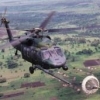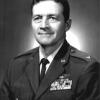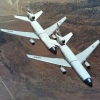In AFGSC the Huey crews regularly take missile maintenance personnel out to the sites to conduct short notice or after-hours repairs. The 341st Missile Wing’s ICBM complex in Montana is 13,000+ square miles and some sites take almost a 4 hour drive to reach, one way, hence the need for helicopters to provide security and support. Off-base convoys are used to transport the weapons from the sites to base in order for maintenance to be performed on the warheads. The helicopter squadrons regularly run into crew duty day issues on these long sorties due to the length of drive and ETIC times for the required maintenance actions at the site. For this reason a crew is usually designated to show six or so hours later than the primary crews to ensure that the convoy always had helicopter support.
One bright, shining spring day I was scheduled to fly an instrument/EP sortie with a relatively new co-pilot. We were also scheduled to provide backup for the weapons convoy that was heading out to one of the furthest sites in the complex. We completed the training sortie without too many issues, an easy 2.5 with multiple beans logged and returned to the squadron to catch up on the standard Missile Wing queep. About an hour after we landed we got word that the convoy was delayed two hours due to MX, standard. Thirty minutes later the Ops Sup got a call from MOC requesting helicopter support for the affected site. A critical part forgot to be packed in the van the night before and the convoy wouldn’t be able to leave the site without it. Without a helicopter flight MMX would be forced to drive four hours to the site, deliver the part, as well as drive four hours back. This of course would exponentially increase the duty days of 14 aircrew and 100+ maintenance/security personnel currently sitting at said site awaiting the part. Our crew started to spin up for the mission; coordinating with MOC to determine the personnel and gear required, pre-flighted the aircraft, and other aircrew duties to be ready to turn blades as soon as the maintenance personnel got to the squadron. When the two maintenance guys arrived they were carrying their “critical component” in a pelican case the size of a hardback novel. We strapped in, cranked engines, and were in the air in ten minutes. The site was plugged into our trusty-rusty GPS and preceded Vne direct at a blistering 110 knots.
As we were flying across rural Montana at 100 feet we started to converse with the airmen in the back. Neither of them had been in a helicopter before and we tried to make it the best flight that we could. The weather was warm enough that we could pin open the doors so they could get the best view of the countryside. We couldn’t deviate to sightsee too much because we had somewhere to be but on the return trip we would have plenty of gas to “explore the space” if you will. Almost an hour later we arrived on scene and landed right outside the launch facility gate. Both airmen ran out, threw the pelican case over the fence and ran back, and we pulled pitch with less than two minutes spent on the ground. We headed south into the mountains and started to show the airmen what a 9,000 pound, 45-year old Huey could do. Yanking and banking at 50 feet through the coulees and mountains is the best part of the job and we tried to put on a good show for the passengers. They were both sitting sideways in the alcove seats and with each bank and pull they would either see ground or sky but not much in-between. If you’re not ready it can be disorienting very quickly. We always brief the passengers to tell us when they’re getting sick so we can mellow out and they can fetch a barf-bag or let their symptoms settle. Many passengers though try and fight it as long as they can and when they notify the crew it’s usually too late. Unfortunately for the airmen on the left this was the case. He was barely able to get out a “slow it down” before he let it go. Fortunately though it was not too forceful and he made all of his lunch, leftover spaghetti squash casserole, in the bag. He tied it off and the FE jettisoned it to prevent it from being a FOD or biohazard. We mellowed out the flying as we cleared the mountains and re-entered the prairie.
The airmen on the right ragged on his buddy for yarking persistently begging us to fly lower and turn tighter. After 20 minutes of this we relented and the left airman insisted that he was good and he promised that it wouldn’t happen again. The FE gave him another barf bag just in case and we started to have some fun. Ten minutes and many, many ridge crossings and whifferdills later, we asked how our passengers were doing. Both gave enthusiastic thumbs up so we decided to kick it up a notch. I took the controls and executed an aggressive, for a Huey at least, climb to 3000 feet AGL to set up for a spiral descent. A well-executed spiral descent will be at 60-80 degrees of bank, 2-ish Gs, and generate over 6,000 FPM rate of descent. The recovery will begin a few hundred feet above the ground and recover at 100-150 feet and 90 knots. Like the Chuck Yeager I emulated in those UPT standups 4 years prior I executed the first one like a boss. Rotor stayed loaded, VSI pegged out, and the blades popped so much on the recovery that Wagner would have been roused from the dead to conduct a zombie orchestra had he been buried outside of Lewistown, MT.
Naturally the maintenance guys were excited for their afternoon roller coaster and asked for another. I gave the controls back to the co-pilot for his attempt. Now I had flown with this co-pilot before and tried to refine his spiral descents from a Maverick-stuck-in-the-jet-wash flat spin into something that wouldn’t make me fearful of mast-bumping from the near zero-G flight conditions. As we climbed back to altitude we checked with the passengers to ensure that they were feeling peachy and would be okay enduring the crushing G-forces. They again gave their A-OK and the co-pilot perched off the top and started his descent. Immediately things went wonky. The aircraft jerked and shuddered; unloading and reloading from the numerous rotor checks, throttle cracks, and overbanks as I tried to talk him through the maneuver execution. About three turns into the descent we were back into the flat spin headed out to sea. We spent the next 2000 feet of Class G airspace coaxing the aircraft back into parameters. As the radar altimeter passed through 700 feet he finally got the aircraft into a passable maneuver and we recovered about 300 feet above the ground.
As we rolled out I saw what looked like grass trimmings flying around the cockpit and cabin. Only these grass trimmings stuck to the windshield and instruments glass. It was at this time that the FE began cursing repeatedly at us and Amn Snuffy in the left alcove. Unbeknownst to us in the cockpit, Amn Snuffy did not enjoy the co-pilots attempt at the maneuver. The erratic aircraft control and sub 1G flight did not sit well with his remaining lunch casserole. He attempted to get to the bag but the urges came on too fast to get it untied. As he puked the recirculating slipstream in the alcove, coupled with the unloaded flight condition kept his vomit in suspended animation in front of his face. As the copilot attempted to control the situation with a rotor check, the G-onset crashed this amorphous blob into his lap and aerosolized the chewed spaghetti squash into a green-out in the cabin of the helicopter. Every surface and object that was exposed including the pubs bags, helmet bags, and our FE was covered in half-inch pieces of Mrs. Amn Snuffy’s Thursday night meal. Luckily the smell wasn’t as bad as the cleanup would be. In the next 30 minutes all of the vomit dried and caked to whatever space it was currently occupying.
After we landed and were hover-taxiing to parking we briefed both airmen on the proper etiquette and expectations for physiological incidents on the aircraft. The co-pilot and I shut down the aircraft as the FE ran to the phase-dock and returned with a pressure washer. They spent the next hour spraying the floor and scrubbing the inside of every nook and cranny of the aircraft, not to mention the bags and maintenance kits that were still caked in vomit particles. While they were cleaning we asked them what they thought of their afternoon. Even though they were covered in vomit and soaking wet from the pressure washer they said that they had the best afternoon yet in the ICBM world. Especially since their fellow MMX buddies still had 2.5 of driving left before they got back to base. Makes you appreciate that even the worst day of flying is still better than an afternoon in missiles.
















